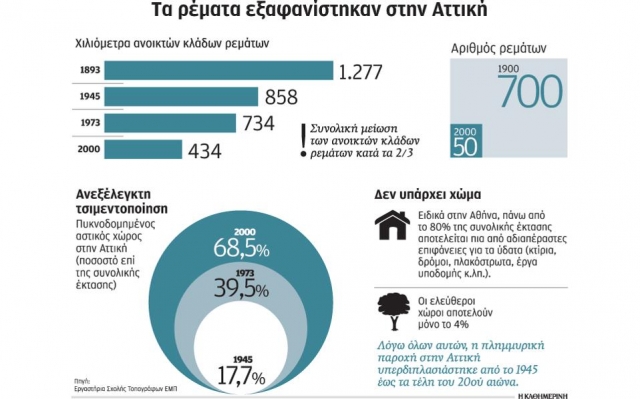www.matrix24.gr
''Under the cobblestones, the beach''. This is what Paris students shouted in May 1968 while protesting against the cementing of their city. There are streams under the asphalt – this can be said about Attica in 2014. Attica’s rivers and streams have long been forgotten, with most of them buried under concrete and asphalt. By the late 19th century, Attica had 700 streams. In the early 21st-century, there are no more than 50. But they share a bad habit: however much they bury and forget them, they tend to re-emerge every time abundant showers drench the country – which is what happened 10 days ago in West Attica, for instance. The result is floods and destruction. A lot has been said about taking the measures needed to address flooding, haywire development, infrastructure shortages, and truncated national or municipal budgets that leave the city unprotected.
There is an underlying reality in Athens and its Attica region, which exacerbates the flood problem and makes its solution an uphill task. Back in 1893, 1,277 kilometres of open streams were running across Attica. Ever since then, up until the early 21st century, the development of suburbs and the creation of multiple satellite residential areas across the region have dealt a death bunch to open rivers – whether it was done in an entirely haphazard or in a relatively organised way, through the incremental putting of infrastructure in place. The early 21st century sees an Attica with only 424 km of open streams, i.e. they have declined by two thirds. This data comes from the laboratory of re-cultivation and water resource management and the laboratory of photogrammetry of the Geodesy Faculty. It is apocalyptic.
Meanwhile, the cementing of the central Attica plains has gone beyond any reasonable limits. Back in 1945, only 17.7% of the region was densely developed urban space. In 1973 it already was 39.55% while in the year 2000 it reached 68.5%. In more specific terms, within the Athens agglomeration, over 80% of the overall area comprises surfaces impenetrable to water, e.g. buildings, roads, pavements, infrastructure, etc. The area covered with soil, ordinary water-absorbing soil, is assumed to be no more than 20%. Professor of urban planning Yiannis Polizos has recently argued that free spaces in Athens do not exceed 4%. It is obvious that in these conditions Athens has become a water accelerator. Researchers from Athens Polytechnic have found that flooding has been exacerbated by the city’s being cemented over. According to their study, floods in Attica have doubled from 1945 until the late 20th century.
And if deforestation, especially around Athens itself, which urges waters down mountain slopes much faster, is taken into account, the gravity of the issue becomes even more apparent.
Turning the tide is not easy by any means, and it will take a long time to materialise. Becoming aware of the issue is just the beginning. First off, destroying the natural environment in the region should be halted. Then comes a variety of measures designed to reverse the trends. Free spaces in Athens should proliferate and be transformed into green oases, complete with soil and vegetation. Pedestrian and amenity areas, or even some bigger parking lots, should be redesigned into parks, with soil or other materials allowing partial water permeability: this way some of the precipitation will be locally absorbed. Residential buildings or compounds will have to be surrounded by free space, instead of inexorably concreted. Such interventions will not only help Athens control its floods, but reduce the heat of its sweltering summers and improve the quality of life for its citizens.

www.kathimerini.gr
Conventional measures against flooding have not been successful
Traditional flood prevention approaches have been based on boxing up the waters, putting concrete on slopes and tight stream regulation. In its Greek version, rampant cementing has led to the vanishing of water streams under motorways, while underground development has deprived the city of water and natural ventilation. These methods have been strongly criticised internationally. Milder interventions, following the age-old natural patterns, are now replacing the exorbitantly expensive, radical development projects, which have proven ineffective in many ways. Concrete-packaging thoroughly destroys the natural streaming of water. Impenetrable materials inhibit water absorption and ramp up the outflow. Apart from seriously deteriorating the overall environment, e.g. flora, fauna, open-surface water and landscape, the result is vast outflow volumes and high flood risk. Instead, maintaining the natural shape of streams, water body banks and coastal areas are well-advised to achieve both flood prevention and environment conservation.